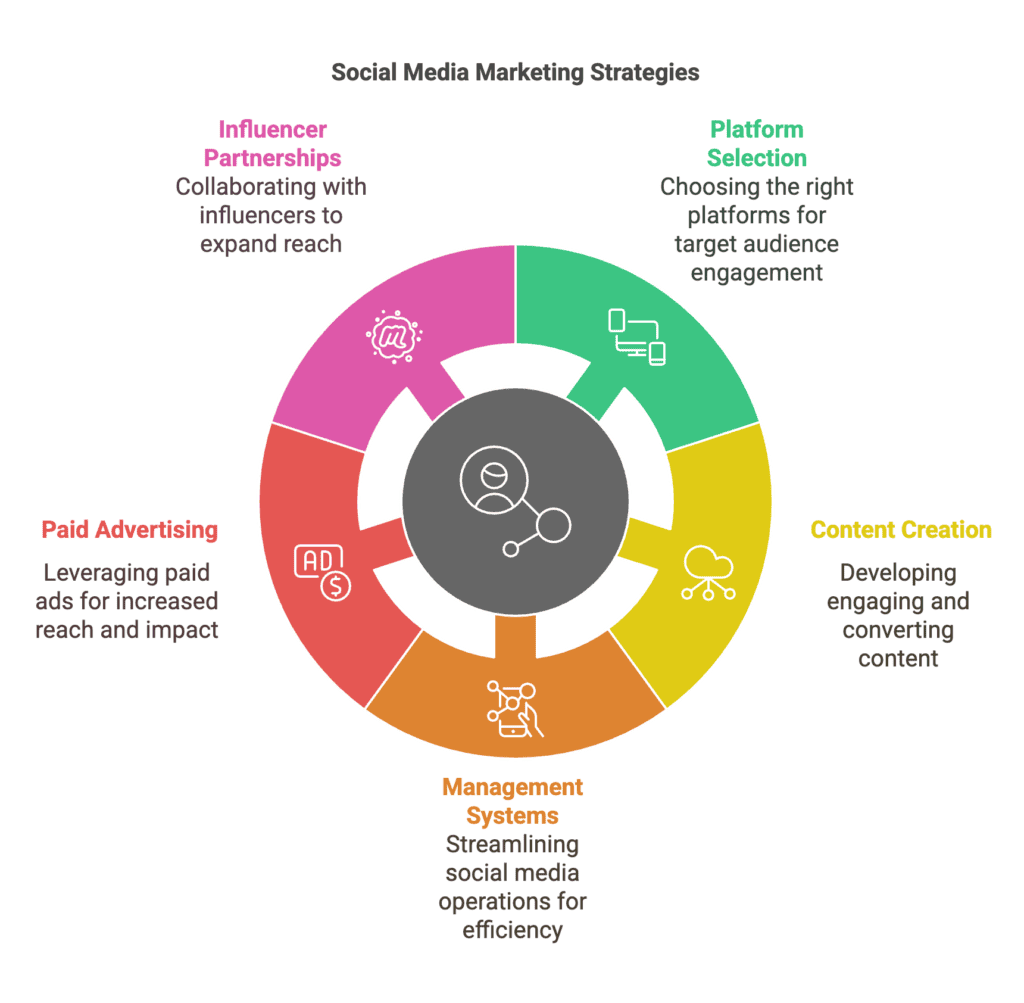In today’s digital landscape, social media marketing isn’t just an option—it’s essential. This comprehensive guide will walk you through everything from platform basics to advanced strategies that drive real business results.
- Platform selection and optimization
- Content creation that converts
- Management systems for efficiency
- Paid advertising strategies
- Influencer partnerships that work
Social Media Marketing Overview
Social media marketing is the process of creating tailored content for each social media platform to drive engagement, website traffic, and ultimately, sales.
When done right, social media marketing can be the most cost-effective way to reach your ideal customers where they already spend hours every day.
71% of consumers who have a positive social media experience with a brand are likely to recommend it to others. That’s powerful word-of-mouth that can transform your business.
The key to success isn’t just posting consistently—it’s understanding the unique psychology behind each platform and creating content that resonates with those specific users.
Many businesses make the critical mistake of treating all platforms the same. This is exactly why they fail to see meaningful results.
Whether you’re just starting out or looking to optimize your existing strategy, the principles in this guide will help you build a social media presence that drives real business growth.
Beginner Task: Identify the top 3 platforms where your target audience spends the most time. Create business accounts on these platforms only—don’t try to be everywhere at once.
Advanced Task: Conduct a social media audit of your current channels. Analyze which content types are driving the highest engagement rates and double down on those formats while eliminating underperforming content styles.
Platform-Specific Tactics
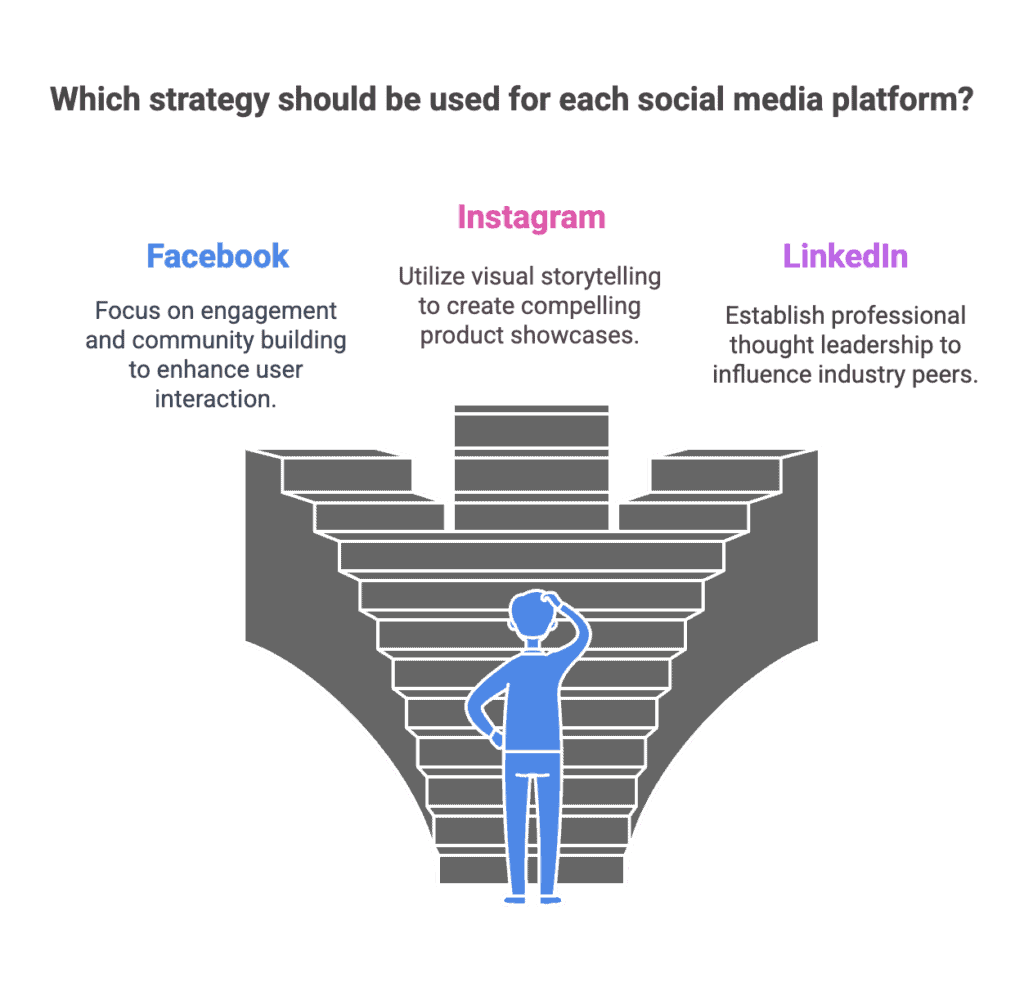
Each social platform has its own unique algorithm, audience expectations, and content format preferences. Let’s break down the winning strategies for each major platform.
- Facebook – Engagement and community building
- Instagram – Visual storytelling and product showcases
- LinkedIn – Professional thought leadership
- Twitter – Trending conversations and customer service
- TikTok – Authentic, trend-driven short video
- Pinterest – Inspirational and educational content
- Reddit – Community participation and subject expertise
Facebook Marketing Playbook
Facebook remains the largest social network with 2.9 billion monthly active users and the broadest demographic reach of any platform.
The Facebook algorithm prioritizes content that creates meaningful interactions between people—especially content from friends, family, and groups.
For businesses, this means your content needs to spark genuine conversations to gain organic reach.
Video content on Facebook generates 1,200% more shares than text and image posts combined. This makes video your most powerful tool for increasing reach.
Facebook Groups have become essential for building community around your brand. Creating and nurturing a group related to your industry (not just your products) can establish you as a trusted authority.
The average organic reach for Facebook pages is only about 5.2% of your page’s total likes. This is why a mixed strategy of organic and paid content is necessary.
Beginner Task: Create a simple content calendar for Facebook with 3 posts per week, focusing on a mix of educational content, behind-the-scenes glimpses of your business, and questions that encourage comments.
Advanced Task: Develop a Facebook Group strategy centered around solving problems in your industry. Create a content plan specifically for the group that encourages member-to-member interaction, not just brand-to-customer communication.
Instagram Growth Strategies
Instagram has evolved from a simple photo-sharing app to a powerful marketing platform with multiple content formats: feed posts, Stories, Reels, and IGTV.
The platform’s algorithm favors content with high engagement in the first 30 minutes after posting, making your posting time crucial.
Instagram Reels now receive 22% more engagement than standard video posts. If you’re not creating Reels, you’re missing a major opportunity for growth.
Hashtag strategy on Instagram remains important but has evolved. Using 5-10 highly relevant hashtags performs better than using all 30 allowed hashtags.
Instagram Shopping features have made the platform increasingly important for e-commerce brands, with 70% of shopping enthusiasts turning to Instagram for product discovery.
Creating a consistent visual aesthetic is particularly important on Instagram. Brands with recognizable visual styles see 25% higher engagement rates.
Beginner Task: Create a signature visual style for your Instagram by choosing 2-3 consistent filters or editing techniques and applying them to all your content.
Advanced Task: Implement a Reels strategy with 2-3 weekly Reels that leverage trending sounds but adapt them to your industry. Track engagement rates against your regular posts and adjust your content mix accordingly.
LinkedIn B2B Marketing Techniques
LinkedIn generates 277% more leads than Facebook and Twitter for B2B companies, making it essential for business-to-business marketing.
The platform’s algorithm heavily favors content that keeps users on LinkedIn rather than directing them elsewhere, so native content and documents perform better than external links.
LinkedIn’s user base is professionally-focused, with 4 out of 5 members driving business decisions. This makes it ideal for reaching decision-makers.
Content that demonstrates thought leadership performs exceptionally well, with long-form posts (1,500-2,000 words) getting the highest engagement.
Video on LinkedIn generates 5x more engagement than other content types, but only 5% of LinkedIn users share video, creating an opportunity for standout content.
LinkedIn’s ad targeting capabilities allow you to target by job title, company size, industry, and seniority—making it unparalleled for B2B advertising precision.
Beginner Task: Create a personal LinkedIn content plan focused on sharing industry insights once a week. Focus on text-based posts with your unique perspective on industry trends.
Advanced Task: Develop a LinkedIn Live strategy with monthly expert interviews or industry discussions. Promote these events through your company page and employee networks to maximize reach.
Twitter Engagement Tactics
Twitter’s fast-paced environment makes it ideal for real-time marketing, customer service, and joining trending conversations.
The average lifespan of a tweet is just 18 minutes, meaning frequency matters more on Twitter than on other platforms.
Tweets with images receive 150% more retweets than text-only tweets, while tweets with video get 10x more engagement.
Twitter’s algorithm prioritizes recency, but also considers user relationships and engagement levels. This means building relationships with your followers is crucial.
Twitter chats and hashtag campaigns can dramatically increase your visibility and position your brand as an industry leader.
The best performing tweets are those that join existing conversations rather than trying to start new ones from scratch.
Beginner Task: Identify 5 industry hashtags and set up a daily 10-minute session to engage with recent tweets using these hashtags. Focus on adding value through comments, not promotion.
Advanced Task: Create a Twitter listening dashboard using TweetDeck to monitor brand mentions, competitor activity, and industry hashtags. Develop a response protocol for different types of mentions with target response times.
TikTok Content Creation
TikTok has evolved from a teen-focused app to a marketing powerhouse with 1 billion monthly active users across all demographics.
The TikTok algorithm is uniquely content-focused rather than follower-focused, meaning even accounts with few followers can go viral with the right content.
Authenticity outperforms polish on TikTok, with behind-the-scenes and “raw” content consistently outperforming highly produced videos.
The platform’s unique “For You Page” algorithm learns user preferences quickly, making hyper-targeted content possible once you understand your niche.
Educational content performs exceptionally well on TikTok, with “learn on TikTok” videos seeing 84% higher completion rates than entertainment content.
Trending sounds and effects are crucial on TikTok—using a trending sound can increase reach by up to 14x compared to original audio.
Beginner Task: Create three educational TikToks teaching something simple about your industry in under 60 seconds each. Focus on valuable tips rather than production quality.
Advanced Task: Develop a TikTok trend monitoring system to identify rising sounds and trends in your industry niche. Create a process for rapidly producing content around these trends within 24 hours of their emergence.
Pinterest Marketing Methods
Pinterest functions more as a visual search engine than a traditional social network, with 85% of users turning to the platform when starting new projects.
The half-life of a Pinterest pin is 3.5 months (compared to 24 minutes for an Instagram post), making it extremely valuable for long-term content strategy.
Pinterest SEO is crucial—proper keyword research and pin descriptions can dramatically increase visibility and drive consistent traffic.
Vertical images with a 2:3 ratio perform best on Pinterest, with infographics and step-by-step visual guides generating the most saves.
Pinterest shopping campaigns generate 3x higher conversion rates than ads on other social platforms, making it particularly valuable for e-commerce.
Consistency is key on Pinterest, with accounts that pin daily seeing 30% higher engagement than those who pin sporadically.
Beginner Task: Create 5 vertical templates (2:3 ratio) in Canva that align with your brand guidelines. Use these to convert existing blog content into Pinterest-friendly images.
Advanced Task: Implement a Pinterest SEO strategy by researching the top 20 keywords in your industry. Create dedicated boards and pins targeting each of these keywords with optimized descriptions and tags.
Reddit Marketing Approaches
Reddit is unique among social platforms, functioning as a collection of interest-based communities (subreddits) with strict norms against overt marketing.
The platform has 52 million daily active users who are highly engaged and influential, with 47% discovering products through Reddit discussions.
Direct promotion is generally rejected on Reddit—value contribution and community participation must come before any marketing efforts.
AMAs (Ask Me Anything) sessions can be powerful for building credibility when conducted by genuine experts with valuable insights to share.
Reddit’s upvote system means that quality content can quickly rise to high visibility, but poor content will be swiftly downvoted and potentially harm your reputation.
Building genuine reputation on Reddit requires a long-term strategy of consistent participation and value-addition before any promotional content.
Beginner Task: Identify 3 subreddits related to your industry (but not focused on marketing). Spend 15 minutes daily for two weeks answering questions and contributing value without mentioning your business.
Advanced Task: Create a detailed Reddit content strategy that includes regular participation in industry subreddits, potential AMA topics from your company experts, and a system for monitoring relevant conversations for organic engagement opportunities.
Social Media Management
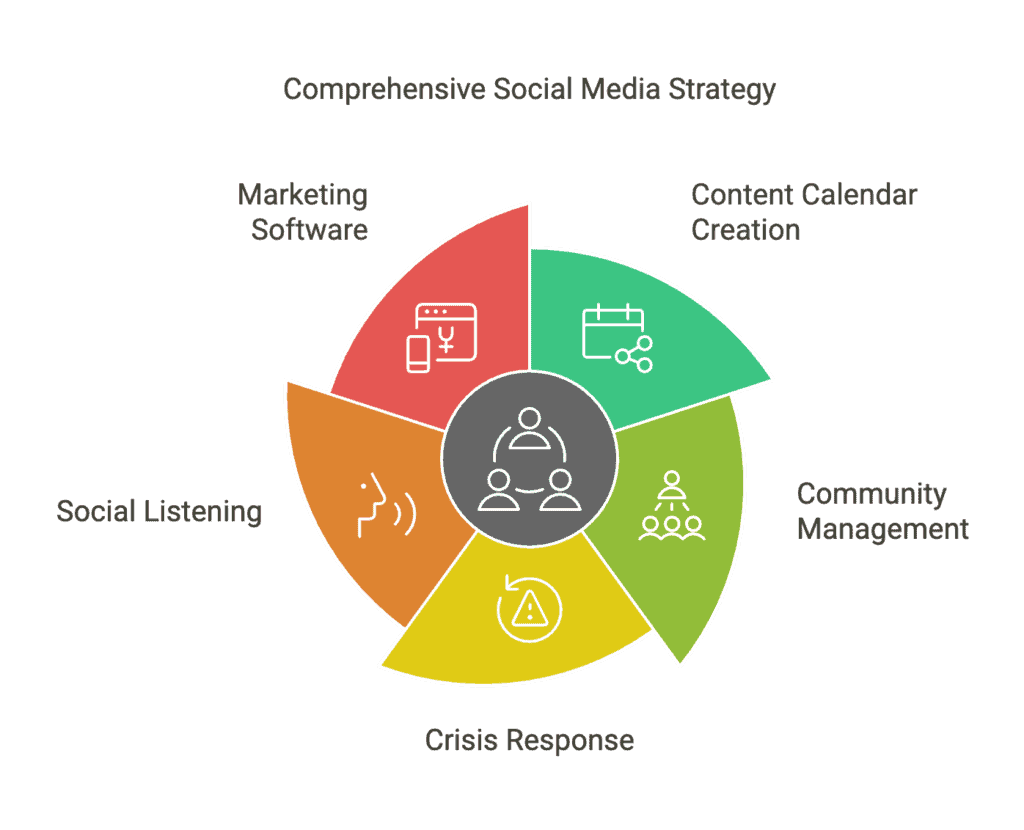
Effective social media marketing requires strong systems for content planning, community engagement, and crisis management. Here’s how to build those systems.
- Creating efficient content calendars
- Managing community interactions
- Preparing for potential crises
- Implementing social listening
- Selecting the right tools and software
Content Calendar Creation
A content calendar is the foundation of any successful social media strategy, allowing you to plan content in advance and maintain consistency.
The most effective content calendars balance planned content with flexibility for real-time opportunities and trending topics.
Research shows that brands using content calendars post 2-3x more consistently and see 38% higher engagement than those posting ad-hoc.
Your calendar should include a healthy mix of content types: educational (40%), entertaining (30%), promotional (20%), and conversational (10%).
For multi-platform strategies, a content calendar should also track platform-specific variations of each content piece to optimize for each channel.
Planning content in batches (typically 2-4 weeks in advance) dramatically increases efficiency while reducing daily social media stress.
Beginner Task: Create a simple content calendar using a spreadsheet with columns for date, platform, content type, caption, hashtags, and visual assets needed.
Advanced Task: Implement a quarterly content planning system aligned with your marketing campaigns and business goals. Include performance metrics from previous quarters to inform content mix adjustments.
Community Management Protocol
Community management goes beyond posting content to actively engaging with your audience and building relationships that drive loyalty.
85% of customers expect a response from brands on social media within 6 hours, but the average response time is over 10 hours—creating an opportunity to stand out.
Effective community management requires clear guidelines for tone, types of comments to respond to, escalation procedures, and response templates for common questions.
Proactive community management (asking questions, initiating conversations) generates 61% more engagement than reactive management (only responding to mentions).
Creating a sense of exclusivity and special recognition for your most engaged followers can transform casual followers into brand advocates.
The most successful brand communities focus on user-to-user connections, not just brand-to-user relationships.
Beginner Task: Create a simple response flowchart for different types of comments and messages (positive feedback, questions, complaints) with sample responses for each category.
Advanced Task: Develop a community advocate program that identifies and rewards your most engaged followers with exclusive content, early product access, or recognition opportunities.
Crisis Response Framework
Social media crises can emerge unexpectedly and escalate rapidly, making advance preparation essential for effective management.
41% of consumers expect a response within 60 minutes during a crisis situation, highlighting the need for rapid response protocols.
An effective crisis framework includes monitoring systems, notification protocols, pre-approved response templates, and clear roles for team members.
The first 24 hours of a social media crisis are critical—brands that respond transparently and quickly experience 63% less negative sentiment than those who delay.
Post-crisis analysis is essential for prevention; 78% of social media crises could have been avoided or minimized with better preparation and early intervention.
Documenting all crisis responses creates an invaluable resource for handling future situations more effectively.
Beginner Task: Create a simple crisis classification system (Level 1-3) with criteria for each level and basic response guidelines for different crisis types.
Advanced Task: Develop a comprehensive crisis simulation exercise for your team to test response times, communication clarity, and decision-making under pressure. Run this simulation quarterly to identify process improvements.
Social Listening Implementation
Social listening goes beyond monitoring mentions to understand broader conversations about your brand, competitors, and industry.
Only 51% of brands actively monitor conversations about their industry (not just their brand), missing valuable insights about customer needs and market shifts.
Effective social listening requires monitoring both direct mentions and untagged references, which typically represent 70% of all brand conversations.
Sentiment analysis tools can help track emotional responses to your brand over time, providing early warning of potential issues or opportunities.
Competitive listening (monitoring competitor mentions) provides invaluable insights for product development, content creation, and customer service improvements.
The most valuable social listening insights often come from analyzing patterns over time rather than individual mentions.
Beginner Task: Set up Google Alerts for your brand name, key products, and 2-3 competitors to receive email notifications of new mentions across the web.
Advanced Task: Implement a comprehensive social listening dashboard using a dedicated tool. Establish weekly reporting focused on sentiment trends, competitive insights, and emerging customer pain points.
Social Media Marketing Software
The right tools can dramatically increase efficiency and effectiveness across all aspects of social media marketing.
Companies using integrated social media management platforms save an average of 15-20 hours per week compared to those using separate tools for different functions.
Key categories of social media software include publishing/scheduling tools, analytics platforms, listening tools, and community management systems.
When evaluating software, prioritize integration capabilities—tools that connect with your existing marketing systems provide 34% more value than standalone solutions.
Automated reporting saves teams an average of 5-7 hours per week while providing more consistent performance tracking.
The most effective social media teams use a combination of specialized tools rather than trying to find a single platform that does everything.
Beginner Task: Implement a basic scheduling tool like Buffer or Hootsuite to streamline posting across platforms and enable batch content creation.
Advanced Task: Conduct a comprehensive audit of your social media workflow to identify time-consuming manual processes. Research and implement specialized tools to automate these processes, measuring time saved and performance improvements.
Paid Social Advertising
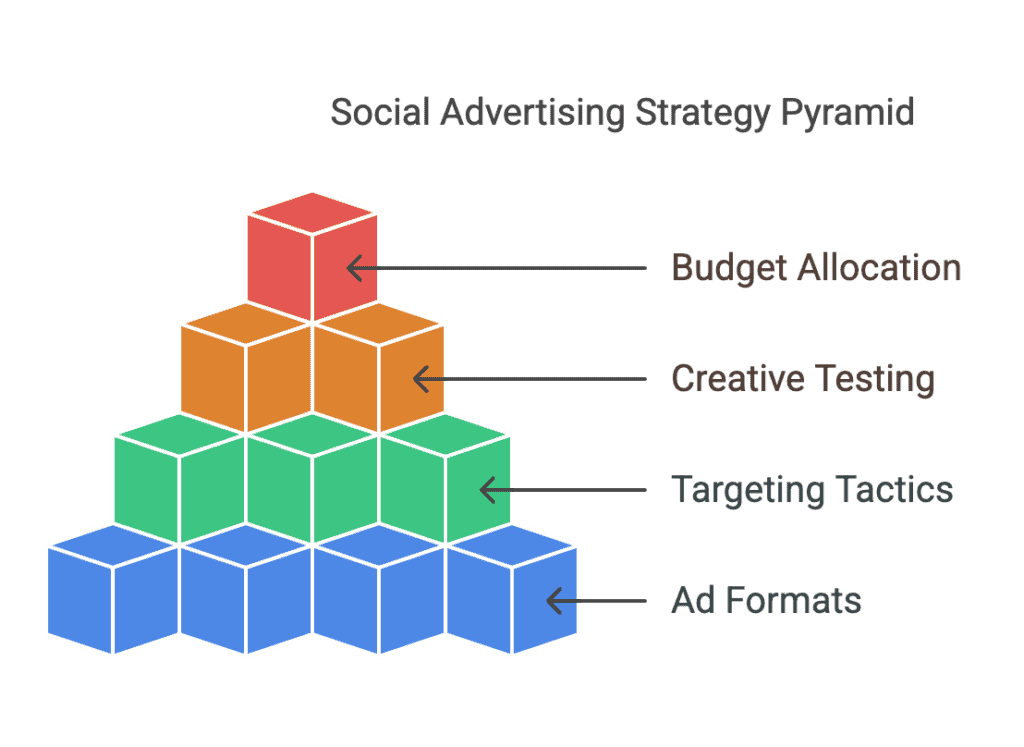
Organic reach continues to decline across platforms, making paid social advertising an essential component of any effective strategy.
- Choosing the right ad formats for your goals
- Targeting strategies for maximum ROI
- Testing frameworks for creative optimization
- Budget allocation across platforms and campaigns
Ad Format Selection Guidelines
Different ad formats serve different marketing objectives, making format selection a critical strategic decision.
Video ads generate 20-30% higher conversion rates than image ads across most platforms, but require more resources to produce at scale.
Collection ads (showcasing multiple products) outperform single product ads by 42% for e-commerce conversions on Facebook and Instagram.
Lead generation forms native to social platforms convert 2.5x better than sending users to external landing pages, particularly on mobile devices.
Interactive ad formats (polls, quizzes, AR experiences) generate 4x the engagement of standard formats and 70% higher completion rates.
Format decisions should be guided by funnel position—awareness content performs best with video, consideration with carousels, and conversion with collection ads.
Beginner Task: Test the same campaign with two different ad formats on Facebook (e.g., single image vs. carousel) with a small budget to compare performance.
Advanced Task: Create a decision matrix for ad format selection based on campaign objectives, available assets, and historical performance data. Implement this matrix across all campaigns to standardize format decisions.
Audience Targeting Tactics
Effective audience targeting is the foundation of efficient ad spend, with the potential to improve ROI by 3-5x compared to broad targeting.
Lookalike audiences based on your top 1% of customers consistently outperform interest-based targeting, with 89% of marketers rating them their most effective targeting method.
Progressive targeting refinement using the results of previous campaigns improves performance by approximately 15-20% per iteration.
Platform-specific targeting advantages exist—Facebook excels at detailed demographics, LinkedIn at professional targeting, and TikTok at interest-based behavioral targeting.
Exclusion targeting is often overlooked but can reduce wasted spend by 20-30% by removing existing customers or previously converted leads from acquisition campaigns.
Testing audience temperature (familiarity with your brand) dramatically impacts creative performance, with cold audiences responding better to educational content and warm audiences to product-focused content.
Beginner Task: Create a simple customer persona document with demographic details, interests, and pain points. Use this to guide your initial targeting parameters.
Advanced Task: Implement an audience testing framework that systematically tests different seed audiences for lookalike creation. Measure downstream conversion rates (not just clicks) to identify your most valuable audience sources.
Creative Testing Methods
Systematic creative testing can improve campaign performance by 40-60% over time, making it one of the highest-ROI activities in social advertising.
Single-variable testing (changing only one element at a time) provides the clearest insights, while multivariate testing allows for faster discovery of winning combinations.
The most impactful elements to test are primary images/videos (30-50% performance impact), headlines (15-25% impact), and call-to-action buttons (10-15% impact).
Dynamic Creative Optimization (DCO) tools can test hundreds of creative combinations automatically but require careful setup to generate meaningful insights.
Creative fatigue occurs faster on social platforms than other channels, with most ads experiencing performance degradation after 7-10 days of exposure to the same audiences.
Establishing a regular testing calendar with weekly creative refreshes prevents performance decline and generates consistent optimization insights.
Beginner Task: Set up an A/B test of two different ad headlines while keeping all other elements identical. Run for at least 7 days with sufficient budget to reach statistical significance.
Advanced Task: Implement a systematic creative testing framework that tests at least one new variable weekly across campaigns. Document all test results in a central creative insights repository to inform future creative development.
Budget Allocation Framework
Strategic budget allocation across platforms and campaigns can improve overall ROAS by 30-50% compared to static budget distribution.
Data-driven budget allocation based on performance thresholds consistently outperforms fixed allocations, with top-performing campaigns receiving incremental funding.
Platform selection should be guided by objective and audience—awareness campaigns typically perform best on Facebook/Instagram, while conversion campaigns often see higher ROI on Pinterest and TikTok for certain industries.
The 70/20/10 rule provides a solid framework: 70% to proven campaigns, 20% to iterations of successful campaigns, and 10% to experimental approaches.
Daily budgets provide more control but often result in suboptimal delivery compared to lifetime budgets with schedule controls.
Regular reallocation (at least weekly) based on performance data is practiced by 87% of high-performing social media advertisers.
Beginner Task: Implement a simple budget allocation framework that moves 10% of your budget each week from lower-performing to higher-performing ad sets.
Advanced Task: Develop an algorithmic budget allocation model using spreadsheet formulas that automatically calculates optimal budget distribution based on ROAS, CPA, and volume potential across campaigns.
Influencer Marketing
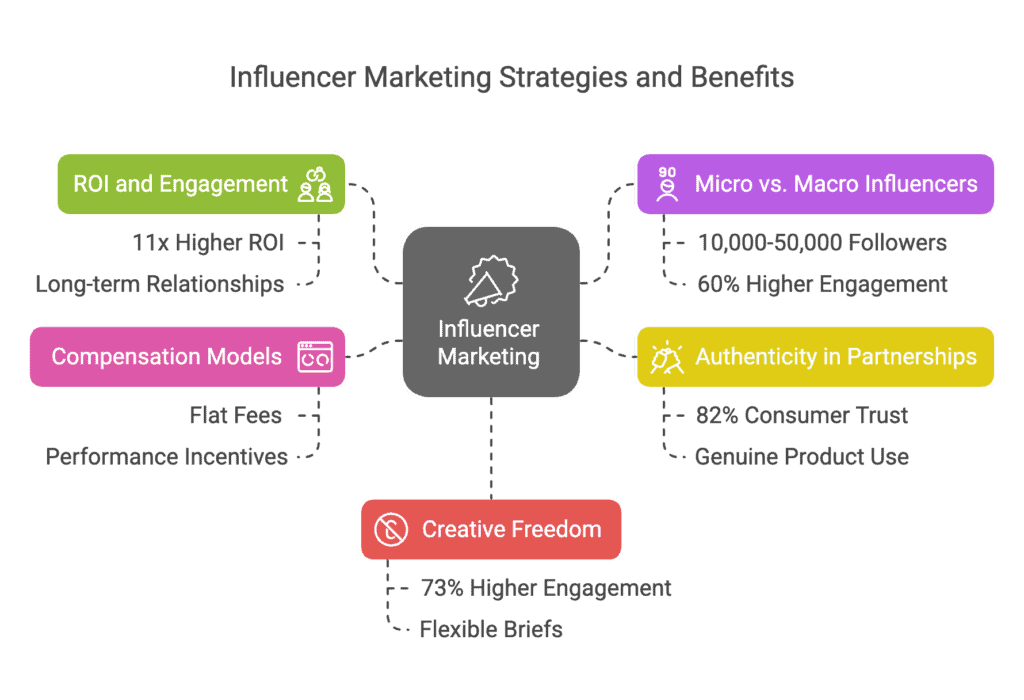
Influencer marketing connects your brand with trusted voices who have already built relationships with your target audience.
Influencer collaborations generate 11x higher ROI than traditional digital campaigns when executed strategically.
The most effective influencer partnerships are long-term relationships rather than one-off promotions, with extended partnerships generating 4.5x more engagement.
Micro-influencers (10,000-50,000 followers) generate 60% higher engagement rates than macro-influencers and often provide better ROI despite smaller reach.
Authentic partnerships outperform transactional ones—82% of consumers trust recommendations from influencers who genuinely use the products they promote.
Performance-based compensation models (combining flat fees with performance incentives) deliver 35% better results than fixed-payment arrangements.
Creative freedom within brand guidelines results in 73% higher engagement than highly scripted influencer content, making flexible briefs essential.
Beginner Task: Identify 5-10 micro-influencers in your niche and engage with their content consistently for two weeks before reaching out about potential collaboration.
Advanced Task: Develop a comprehensive influencer program with tiered partnership levels, clear performance metrics, and progression paths for influencers to move from one-time collaborators to brand ambassadors.
Conclusion
Social media marketing success requires a strategic approach tailored to each platform, audience, and business objective.
Don’t try to be everywhere at once. Start with the platforms that matter most to your audience, master those, and then expand.
Remember: consistency beats perfection. A regular cadence of good content will outperform occasional brilliant content every time.
Take action today by implementing just one strategy from this guide. Small, consistent improvements compound over time into dramatic results.
Your audience is waiting for you to join the conversation. What will you say to them first?
